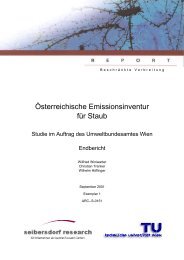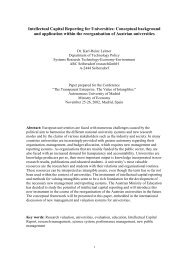ALPMON FINAL REPORT - ARC systems research
ALPMON FINAL REPORT - ARC systems research
ALPMON FINAL REPORT - ARC systems research
You also want an ePaper? Increase the reach of your titles
YUMPU automatically turns print PDFs into web optimized ePapers that Google loves.
Contract ENV4-CT96-0359 <strong>ALPMON</strong><br />
for windows, a GIS system developed by RSDE, was applied. For the Engadine test site, additionally to<br />
RSG the Satellite-Ortho Module from PCI was used.<br />
Geocoding results in most cases were sufficient with sub-pixel accuracy due to parameter adjustment.<br />
Additionally, the overlay of topographic information with geocoded satellite images could demonstrate<br />
good correspondence between the data sets. However, results were not completely sufficient in the<br />
Engadine test site, where significant deviations occurred in high altitudes, mainly in the high resolution<br />
IRS pan image.<br />
Restrictions in the geocoding process of high resolution digital satellite image data and the quality of its<br />
results are mainly related to incorrect pre-processing of the digital image data and a DEM accuracy as<br />
well as accuracy of the reference data not corresponding to the pixel resolution of the satellite image.<br />
Implementation of a co-registration process of the geocoded images further improves the location<br />
accuracy of the geocoded images.<br />
3.3.4 Topographic normalisation<br />
There is a general agreement within the consortium that topographic normalisation leads to an<br />
improvement of the image data in mountainous terrain. In particular the Minnaert correction produces<br />
useful results. The C-correction seems not to be the appropriate solution, but rather tends to extreme<br />
over-correction of steep slopes. However, all corrections are based on empirical analysis thus being<br />
highly depending on the actual image data.<br />
A prerequisite to topographic normalisation is an accurate DEM and precisely geocoded image data.<br />
For an optimum correction the spatial resolution of the DEM should be four times higher than the<br />
spatial resolution of the image data. Using Landsat TM images the required cell size would be less<br />
than 10m, for other image data such as SPOT or IRS-1C it would be even lower. In general there are<br />
no such DEMs available for larger regions. The consequence of using lower resolution DEMs is the<br />
lack of topographic details within one grid cell which might disturb the correction locally.<br />
Geometric displacements between the image and the DEM is another potential source of erroneous<br />
corrections. The model performs the correction according to the DEM. If the image is slightly shifted<br />
the transition between illuminated and shadowed areas will not any more correspond to the<br />
topography. This leads to systematic errors on ridges and in valleys resulting in extreme over- or<br />
under-correction of areas in the magnitude of the displacement.<br />
An ideal result for topographic correction could be obtained if the entire area was covered by one, and<br />
only one cover type. Then it could be assumed that a particular value of the Minnaert constant is valid<br />
for the entire area. In reality this scenario is rather rare, in particular in the alpine area. In order to<br />
optimise the model a priori information on the distribution of major cover types is helpful. The more<br />
cover types are separated the better the correction will be. On the other hand the recognition of these<br />
cover types is the major motivation for performing the topographic correction. So it might be useful to<br />
apply the correction and subsequent classification in an iterative way.<br />
3.3.5 Atmospheric correction<br />
There has been continual discussion on the meaning and quality of divers atmospheric correction<br />
algorithms within the project team during the project meetings as well as regular communication. On<br />
one hand, atmospheric correction seems to be a pre-requisite to accurate quantitative image<br />
interpretation. On the other hand, it has been stated that none of the currently available atmospheric<br />
correction models is suitable for alpine areas.<br />
� Methods not relying on local atmospheric measurements, are too inaccurate. For example, the<br />
Point Spread method seems to be ineffective. Applied on the satellite data the procedure only<br />
sharpened image features. A problem that may occur by using the Tasselled Cap method is, that<br />
the simple linear combination of LANDSAT-TM bands may not produce in every case the desired<br />
new band which is higher correlated to dust. It is not clear to what extent the coefficients, which<br />
were derived from agricultural areas in Michigan in June are valid for other areas and seasons.<br />
Also it should be kept in mind, that haze does not only change digital numbers in a spectral band<br />
but also causes a loss of information.<br />
� Other available atmospheric correction algorithms, like MODTRAN or LOWTRAN, implemented in<br />
ATCOR, strongly rely on information about the atmospheric conditions at acquisition time of the<br />
respective satellite image. This becomes a major disadvantage taking into account the poor<br />
JR, RSDE, ALU, LMU, Seibersdorf, WSL 76




